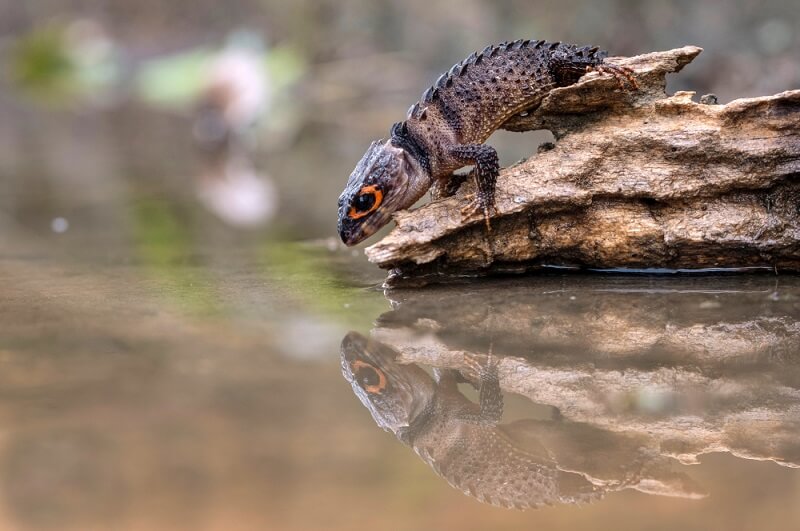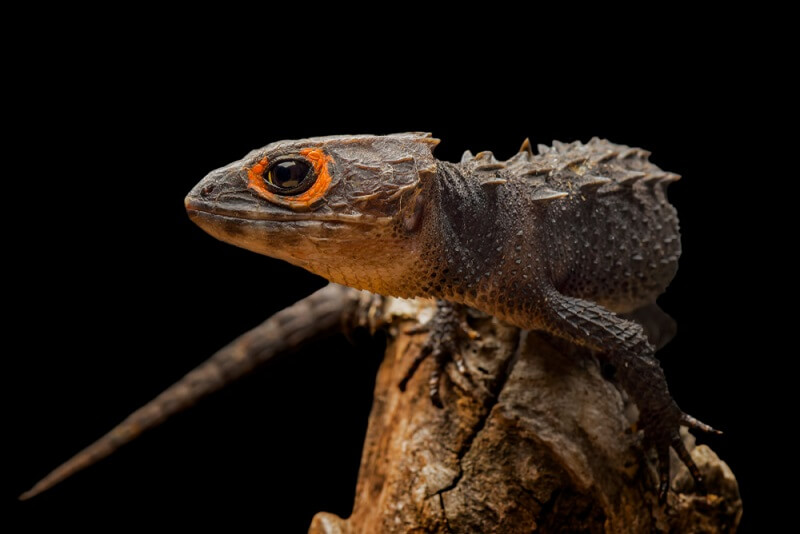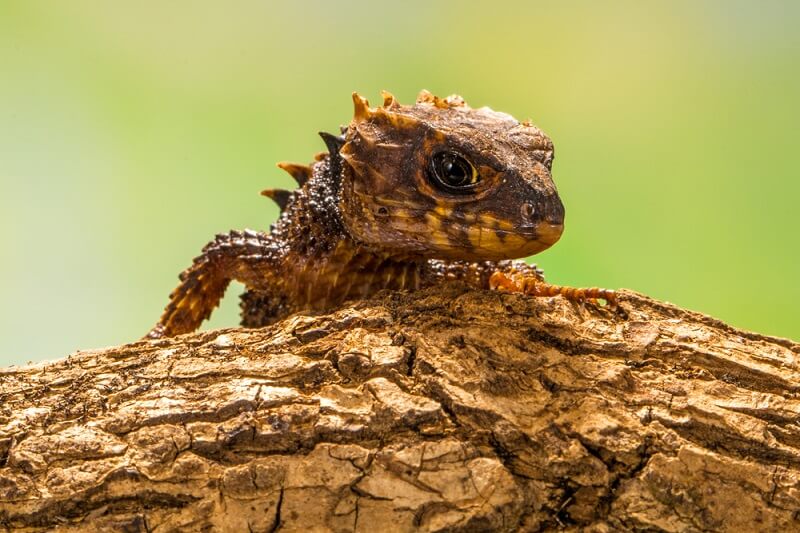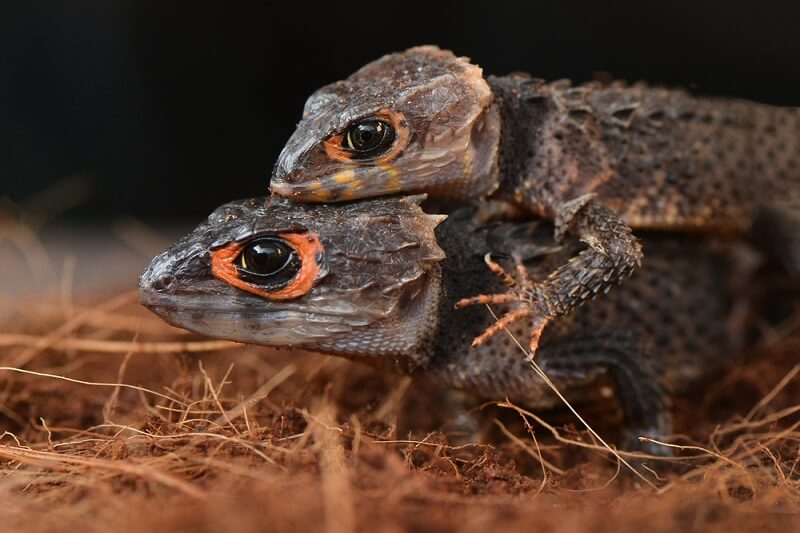
Crocodile skinks are a genus of lizards native to many of the islands in Oceania north of Australia. Several distinct species are found on New Guinea, the Bismarck Archipelago, and the Solomon Islands. Crocodile skinks are part of the Scincidae Family, which contains over 115 different genera and 1,260 species. Like all other true skinks, crocodile skinks actually have bony plates underneath of their scales. This makes them much more resilient to predator attacks. Other skinks, while they have bony protective plating under their scales, do not have the spiny protrusions that make crocodile skinks unique. In general, crocodile skinks are insectivores – though each species may have a very different diet depending on the niche it fills. Many species of crocodile skink dwell near a stream within the tropical rainforest. Crocodile skinks tend to lay only one egg at a time, guard it fiercely while it develops, and protect it for as long as two weeks after it is born! Male crocodile skinks have glands on their feet that are thought to secret an attractant for females. Spread over a vast range of separated islands north of Australia, these lizards have developed a wide variety of features – though they all retain the characteristic bony spines that make them unique among kinks. Most crocodile skinks occupy a niche very close to the water, typically under low vegetation where lots of insect and insect larvae are present. Some people choose to keep crocodile skinks as pets, though it is not clear how well these lizards adapt to captivity – even when reared in captivity. Various reports indicate that crocodile skinks may be very shy, uncomfortable around people, and nervous during handling. However, the species seems to tolerate a wide variety of insects, has low UVB requirements, and a decent lifespan of 5-6 years. Crocodile skinks need fairly large terrariums, with plenty of hiding places to get away from peering eyes during the daytime. Many species are more active at night, but still uncomfortable being watched. Cages must be kept at very high humidity, but temperature requirements for most crocodile skink species are around a comfortable 75-80 degrees. Only one species of crocodile skink is common in the pet trade: Red-eyed Crocodile Skink – Tribolonotus gracilis. While the IUCN has designated the Red-eyed crocodile skink as “least concern,” it is worth noting that little research has been done on crocodile skink populations. Red-eyed crocodile skinks have a bright red ring around their eye – a clear and distinguishing feature. There are many other species of crocodile skink with a large variety of coloration patterns. The crocodile skink is not only a fascinating organism – it shows several different biological concepts in action! Several DNA studies of crocodile skinks have shown that skinks populations have become separated and reunited over time, as ocean levels rise and fall around island chains. Most crocodile skinks are endemic to the island chains north of Australia – a chain of islands that have experienced dramatically different ocean levels through the millennia. When the ocean level is low, the islands become connected by a series of exposed sandbars and strips of land. These passageways allow skink populations to travel to new islands. When the water levels rise, the populations become isolated from each other. Over time, this can lead to allopatric speciation – a type of speciation that results from a geographical separation. Though the conditions on each island are similar, each population of crocodile skinks has slightly different selective forces that lead to different evolutionary paths. Forces like genetic drift slowly change the makeup of each population. Populations of skinks that have been separated for hundreds of thousands of years can easily become distinct species. This is like how a single crocodile skink ancestor evolved to become 10 different species spread throughout the Indonesian islands. To tell the difference between a male and female crocodile skink, you simply look at the bottoms of the feet. Males have distinct pores – known as “volar pores” – that are theorized to release scents as the males travel around. While more research needs to be done on crocodile skinks specifically, this is a very common trait in many terrestrial animals. In water, scent-marking does not work because substances quickly dissolve into water and are evenly distributed – making the source impossible to find. In the air, however, scents stay more concentrated near their source and allow animals to follow a concentration gradient. Since female crocodile skinks do not have these secretory pores on their feet, it is assumed that male crocodile skinks are secreting an attractant to lead females to the male. This is backed by the observation that crocodile skinks are solitary, shy animals – a scent may help them find each other while remaining hidden from other animals! Interestingly, female crocodile skinks show a high level of parental care. Some reptiles species, such as the Green Sea Turtle, simply lay their eggs in a nest and leave them to hatch – months later. The crocodile skink, on the other hand, lays only 1 egg and wraps around it tightly during its entire development! Plus, newborns stay with their mothers for up to 2 weeks after hatching. That makes crocodile skinks one of the most committed reptile parents around. This also shifts where crocodile skinks fall all the spectrum of reproductive strategies. Other reptiles are mostly r-selected organisms (they produce many eggs and exhibit little parental care). Since crocodile skinks produce only 1 offspring at a time and protect it for up to 2 weeks, this shifts their reproductive strategy closer to K-selected organisms that invest heavily in each offspring. Though humans and other K-selected species invest far more into their offspring, the crocodile skink is certainly convincing evidence that reproductive strategies have evolved to fall on a wide spectrum and that a common ancestor like a fish could have led to advanced parental care – such as that seen in mammals!
Kingdom
Animalia
Phylum
Chordata
Class
Reptilia
Order
Squamata
Family
Scincidae
Genus
Tribolonotus
Species
10 Distinct Species
Niche
Insectivorous
Length
8-10 in (20-25 cm)
Weight
<1 lb (<2.2kg)
Lifespan
5-6 years (up to 12 in captivity)
Social Structure
Solitary
Conservation Status
Least Concern – more study needed
Preferred Habitat
Tropical Forests – particularly near streams
Average Clutch Size
1
Main Prey Species
Insects
Predators
Larger reptiles, mammals, and birds
The Basics

Crocodile Skinks Commonly Kept as Pets

Interesting Insights from the Crocodile Skink!
Speciation on Islands

Scent Marking

Maternal Care in Reptiles
